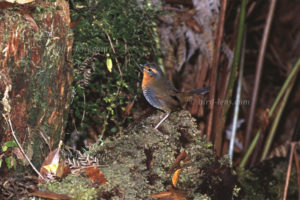 A thicket of bamboo, ferns, mushrooms and moss in the interior of the forests of Patagonia offers many animals hiding places. The king of the forests is the Chucao Tapaculo (Scelorchilus rubecula), a small bird with an artistic and loud reputation typical of the rainforests of southern Chile. However, normally it lives very hidden and is therefore difficult to observe. I just tried it with a tape and sitting quietly in the dense rainforest of the Pumalín Park/ Chile. The Tronador campsite north of Caleta Gonzalo is an excellent base to explore this park is its pristine Nothofagus forests. The campground is situated 46 kilometers north of the small town of Chaitén.
A thicket of bamboo, ferns, mushrooms and moss in the interior of the forests of Patagonia offers many animals hiding places. The king of the forests is the Chucao Tapaculo (Scelorchilus rubecula), a small bird with an artistic and loud reputation typical of the rainforests of southern Chile. However, normally it lives very hidden and is therefore difficult to observe. I just tried it with a tape and sitting quietly in the dense rainforest of the Pumalín Park/ Chile. The Tronador campsite north of Caleta Gonzalo is an excellent base to explore this park is its pristine Nothofagus forests. The campground is situated 46 kilometers north of the small town of Chaitén.
A combination of coldness and humidity is responsible for the formation of damp-temperate rainforests in southern Chile. Over a million years the forests were isolated by climatic and geographic conditions: the mountain massif of the Andes in the east, the dry climate in the north and the Pacific Ocean in the west. As a result, a unique animal and plant world developed in the forests. The Chilean rainforest stretches from the river Maule to the extreme tip of the country to Tierra del Fuego. Traveling from north to south, the annual average temperature drops from 12 to 5 degrees, but the rainfall increases by three. In the region around the river Maule, the Mediterranean forests gradually merge into the lush semi-decidious trees of the moist-tempered rainforests, while Araucaria grow on the mountain slopes. Further south, at the height of the town of Valdivia, the average rainfall per year is considerably higher, favoring the growth of mosses and epiphytes. Between countless lakes and snow-capped volcanoes there are moist, evergreen tree species.
Continue to the Araucaria forests. After about 8 hours drive from Santiago de Chile to the south you leave the Panamericana, which crosses the continent from north to south, and reaches the first evergreen Araucaria forests on the mountain chain of the Andes. Continuing towards the south, the evergreen mixed forests of different oak species and conifers, among which the Alerce stands out because of its size and its high age – the trees are up to 3,000 years old. A visit to Puyehue National Park and the Andean Alerce National Park east of Puerto Montt is worthwhile. Above the varied landscape of the two parks, numerous volcanoes thrive, and the rivers flow through impressive gorges that have formed during the last ice age. The animal world of evergreen forests is relatively poor in birds and mammals, but rich in insects and amphibians. Among the rare species of mammals is the South Pudu (Pudu puda), the smallest species of deer in the world, which used to have a fairly wide distribution in the Andes, but today is regarded as threatened and can only be seen with a lot of luck. On the rivers, the feathered specialists for fishing in these cold waters can be observed: Ringed Kingfisher (Megaceryle torquata). This is a large, conspicuous and noisy kingfisher commonly found along the lower river valleys. Other interesting birds are the Black-throated Huet-huet (Pteroptochos tarnii) and the Ochre-flanked Tapaculo (Eugralla paradoxa). They are closely related to the Chucao Tapaculo. Also Thorn-tailed Rayadito (Aphrastura spinicauda) and the Des Murs’s wiretail (Sylviorthorhynchus desmursii), which feed on insects living in the trees, fill the air with life. In the crowns of trees the Emerald Forest Frog, or in Spanish, sapo arboreo (Hylorina sylvatica) looks for prey. It is characteristic of these forests and is also one of the most attractive inhabitants with its green-gold coloring.
The Chucao Tapaculo (Scelorchilus rubecula) – sometimes only called “Chucao” inhabits mainly the southern parts of Chile, from Bío Bío south to Aisén. The immediate adjoining parts of the Argentinian Andes (from Neuquén to Chubut) are also populated. There are 2 subspecies, the non-nominee form is located on the island of Mocha in southern Chile. In the Pumalin Park, the small bird, reminiscent of a Robin (Erithacus rubecula), occurs in thickets of Chusquea bamboo in damp rainforests, which are dominated by Nothofagus beech.
To cope with the growing demand for top shots of the rarer species of the Palearctic Bird-Lens is keen to enrich the range of pictures of birds not only for the Western Palearctic. Trips to remote places to capture images of rare birds were very successful. The nice images you find in in the blog is only a first impression, what you will find in the gallery in the “Picture Shop” very soon. Just give me a message, if bird-lens.com could serve you with an image needed before the new pictures are online.